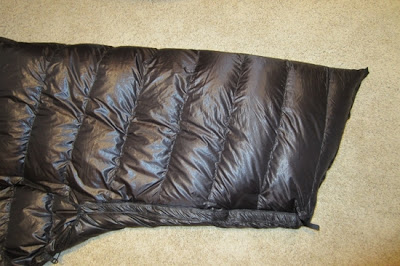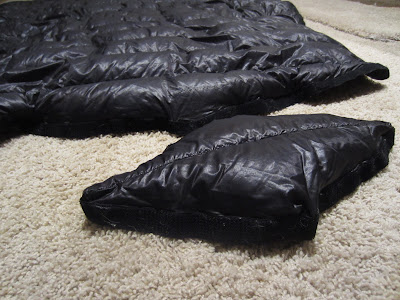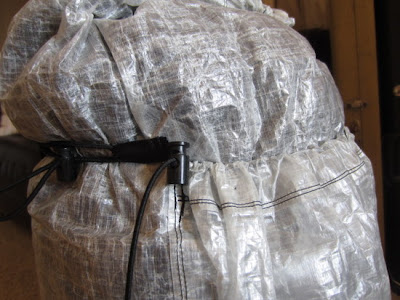Some of my backpacking buddies have been asking about a list of UL gear as a place to start lightening their pack weight. This is a brief list of some Ultralight Backpacking Essentials that have worked for me . . ,
What is Ultralight?
Ultralight simply means having a base weight under 10 lbs. Base weight is the weight of all your gear not counting consumables (food, water and fuel).
Ultralight Backpacking Essentials:
A good place to save weight is with “The Big Three”: Your Pack, Shelter and Sleeping gear.
Using the lightest items below it is possible to stay around 3 - 4 lbs for “The Big Three”. . .
I am simply a humble amateur and although there are some experts I am not one of them. That being said here are some ultralight essentials that have worked for me:
I have one of these (but with a detachable hipbelt) and it’s great. This pack weighs 7.4 oz for 2,600 c/i’s, which is plenty of room for whatever kind of trip you want. Joe Valesko makes these by hand and did his 2,600+ mile thru hikes using this pack. It is made from super strong cuben fiber, it has a built-in padded hipbelt and carries 20lbs just fine. It looks a little strange, cut it’s cutting edge. The material is very strong for the weight. Frameless, so you just use your sleeping pad inside the pack to create structure. There are lots of options to customize as you wish. Current wait is about 4 weeks.
I have one of these. It weighs 24 ozs. It’s great if you want to carry a little more gear and weight. I used this one at Dinkey Dome when carrying gear for both Candy and I. It has an internal frame and it’s a good way to ease into the ultralight deal. Carries up to 35 lbs comfortably. Ready immediately.
.
OR
I have one of these and it is Candy’s main pack. It weighs 8.1 ozs!. Great for loads up to 12 lbs total. It is delicate but extremely light.
OR
Zpacks Arc Haul: http://zpacks.com/backpacks/arc_haul.shtml
Good for loads over 30 lbs. I just ordered one of these (as of 05/05/2015) and although there is a six week waiting list I was able to order it with several custom options. Sometimes on trips over 8 days I need a heavier pack to carry extra food or heavier winter gear. Review to follow!
I have one of the solo tents, it’s amazing. At 8 oz it’s the lightest fully enclosed tent available (10 oz for the twin). It uses a somewhat strange technique of putting your ground sheet on top of the netting. He also used this for his 2,600+ mile thru hikes. I got it without the optional “beak”.
Six Moon Designs Haven Tarp and Inner Net Tent: http://sixmoondesigns.com/tarps/69-haven-tarp-cuben.html
I use this modular setup when camping with my wife Candy.
At 26 ozs it is the lightest two person/two door/two vestibule fully enclosed double wall tent available. It uses two trekking poles to setup. It's possible to use just the net tent on warm nights, just the tarp for 360 degree rain protection or both at the same time for a full double wall shelter. The tarp only weighs 10 ozs which is less than most one person shaped tarps with 360 degree protection (like the MLD solomid).
Six Moon Designs Skyscape X:
http://sixmoondesigns.com/tents/ssX.html
This is a hybrid double wall shelter for one person. It is 80% double wall with only a small area that is single wall. There is an attached inner net, a bathtub floor, two vestibules and 360 degree protection. This is a very stable shelter as it uses two trekking poles in a V shape inside. The one I received weighs 14.5 ozs. I have used this in the High Sierras during all night storms for several nights in a row at 11,000 feet with no problems. Slept like a baby.
Mountain Laurel Designs Solomid:
http://www.mountainlaureldesigns.com/shop/product_info.php?cPath=47&products_id=137
This is the shelter that professional adventurer Andrew Skurka (see
http://andrewskurka.com/ ) used on his 4,800 mile Alaska trip. Although it is advertised as weighing 11 ozs for the cuben version I custom ordered one with the lighter cuben fiber (0.51 oz/sqyd) and it only weighs 8.6 ozs. This is an amazing shelter. I used it during a five day snowshoeing trip last winter in the High Sierra and slept like a baby. It is a floorless shelter that provides 360 degree protection from wind, snow, rain etc. It does not provide bug protection and it does not have a floor so it is not appropriate for the early season when bugs are a problem. I use a poncho/ground sheet for the floor. If you are interested in photos of this shelter check out my trip report:
Glacier Divide Winter 2013
11 oz solo tarp tent and rain gear and backpack rain cover. This thing provides full 360 degree coverage as a shelter AND it’s a poncho for full coverage rain gear AND it’s a pack cover in case of rain AND it can be used as a bivy/sleeping bag cover. This is a great multi-use item. I have one of these, and they are currently available. You can also get the Serenity Net Tent, an inner net tent to protect from bugs, or also to use alone to sleep under the stars. The inner net tent is about 8 ozs.
OR
Another option is to use a tarp and a bivy. As a modular setup the good thing with this setup is that you can sleep under the stars but still protected from bugs etc by just using the bivy. . . or just the tarp for basic weather protection. . . or both for full protection. While on a JMT thru hike in 2010 I used a tarp and bivy setup that only weighed 7.1 ozs for both!
Here are links for the lightest tarp and bivy:
Think ‘Sleeping System’ and you can use a much lighter sleeping bag along with silk long johns to extend the warmth range by another 10 degrees without adding any weight (I bring silk long johns anyway). May PCT thru hikers use these 40 degree bags. So even with this ultralight 40 degree bag, it’s possible to stay warm at below freezing temps. Nice.
Sleeping quilt:
Basically a sleeping bag without a bottom, quilts are really popular with ultralighters. The benefit is that you don’t waste down on the bottom where it will just be compressed and not useful. Also, you can totally spread out without the claustrophobic feeling of a bag. All of the down is on the top and sides. My next project is to make one myself using the Thru-hiker pattern. Quilts typically weigh about 16-18 ozs for a 30 degree temp rating. I’m not sure this is something you’re interested in, but here’s a few links:
Therm-a-Rest NeoAir X-Lite:
12 oz full length inflatable sleeping pad. This is a luxury item, but it is amazingly light weight and totally comfortable. This link is for the ‘regular’ size, its 20” wide, 6’ long and seems like it may be a little longer.
Gossamer Gear Nightlight:
Ground cloth:
Gossamer Gear Polycryo:
1.5 oz ground cloth. 40” x 96” is more than enough room for a solo ground cloth, and it’s a deal for $8.00 you get two.
Poncho/Groundsheet/Pack Cover:
http://zpacks.com/accessories/groundsheet_poncho.shtml
I made one of these with light material and it weighs 2.5 ozs (with sleeves). Amazing triple use item. If you consider the typical weight of even the lightest options for a groundsheet (1.5 oz), pack cover (1.1 oz) and rain jacket (5 ozs) the Poncho/Groundsheet/Pack Cover saves over 5 ozs.
Stakes:
0.2 oz 6.5” titanium stakes. The lightest stakes available.
Cooking:
Caldera Keg:
Although this is sold as a 6.3 oz complete cook set I just use the parts I need. I just use the Fosters can, lid, ‘cozy’ and a gramcracker esbit stove. With these options my
entire cookset weighs under 3 ozs. Just use the Foster can as a cookpot/mug/bowl or whatever.
Winter Stove System:
http://seatosummitultralight.blogspot.com/2013/05/winter-stove-system-2012.html
The extra weight of my winter stove system is due to the need to melt snow for water. Although the stove system weighs 5.4 ozs it is also heavier due to the canister fuel.
Eating utensil:
The GSI Telescoping Foon is a spoon/fork combo that folds into half the size that can easily fit into your cookpot. These are delicate and most of mine have broken after a few years.
Water treatment:
Aqua Mira is THE lightest and most convenient way to safely treat water. I repackage the A and B solution into smaller dropper bottles. By mixing the solution into a small mix bottle each morning I have everything I need for the day. All this for under 2 ozs.
http://zpacks.com/accessories/aquamira.shtml
¼ oz Dropper Bottles:
These are priceless, never carry more than you really need of all misc stuff. Superlight ¼ oz small bottles (they only weight 0.2 oz). I use these to repackage and carry everything from sun screen, bug repellant, campsuds, aqua mira etc. Here’s a link:
Stuff sacks:
Cuben stuff sacks are the lightest. I just make my own and I can hook you up with some good ones to start. Zpacks also has a great selection. A nylon stuff sack weighs 3 ozs. The same size cuben stuff sack weighs 0.20 oz.
With these layers you’re good down to well below freezing, rain or shine for around 24 ozs. Multi-use as they are also part of the sleep system.
Base layer(s):
Smartwool merino wool microweight t-shirt. I can wear one of these for a week without washing and it does not get funky. Better than synthetic, amazing, 4 ozs. Cool in the summer/warm in the winter. Pricey but worth it:
Silk long johns.
Good in the summer. These are multi-use. Worn at night or early morning under a wind shirt/pants to hike and they can also be used as part of your sleep system to warm up your ultralight sleeping bag another 9-10 degrees warmer. They only weigh 3.3 ozs each and are plenty warm for around a campfire in the summer. Amazing. The weight of these with wind shell pants is under 6 ozs, they are warmer than just jeans alone which are 24 ozs. . . dude!
Merino wool long johns.
Good in the fall/winter for colder weather. Smartwool makes microweight merino wool long johns. Amazing warmth for very light weight. These things weigh under 6 ozs each and I was sweating in the store trying them on. Good if you’re expecting very cold weather at high elevation etc.
Puffy Down Jacket:
Mont-Bell Ex Light Down Jacket:
5.7 oz ultralight, compressable and warm down jacket. I have one of these in large, it’s 6.1 oz for the large size. 900 fill goose down, super light, and super warm. A must have for UL packing.
Black Rock Gear Ultralight Down Vest:
http://www.blackrockgear.com/vest.html
4.9 oz ultralight down vest with 2.5 ozs of 900 f/p down!! I returned my size Large as it was a little too snug around the chest and neck. I'm 6' 200 lbs in the off season and down to 185 lbs after a long thru hike. I got an XL and it fits great.
Wind shell/shirt:
I just made one of these using the Thru-Hiker.com pattern, it’s 2 ozs. The whole windshirt thing is big with ultralighters. Basically a windbreaker, it’s a great way to get an amazing amount of warmth/wind protection with very little weight. It’s also rain resistant, so you can wear it until/if the rain gets bad enough to get out your ‘serious’ rain gear.
If you’re interested in making one I already have the pattern, but it’s probably easier to just buy one. Mont-Bell makes a good 2.3 oz windshirt (with a hood!). It was recently very well reviewed on Backpackinglight:
Shell pants:
I also got the pattern to make my own from Thru-hiker.com for UL nylon shell pants, 1.9 ozs. I used to use those shorts with zip on pants legs which work fine, but the shorts were uncomfortable to hike in. Now I just use lightweight nylon Nike shorts to hike in and change into these shell pants if it gets windy/cold. This is just a preference thing. . .but bringing a separate pair of jeans and cotton shorts is out. My jeans weigh 1.5 lbs. Dude. Here’s a link to lightweight wind shell pants:
Rain gear:
DriDucks is the lightest, most breathable and cheapest way to go. They are a little delicate (especially the pants), but how often do you really need them anyway. $25 for the top and bottoms:
OR
The TNF Triumph Anorak rain jacket: A 5.9 oz fully waterproof rain jacket and wind jacket outer shell. I have one of these in large. This is THE lightest rain/wind shell I could find. Expensive and sometimes hard to find in stock.
Shoes:
Trail runners are the UL shoe of choice. No need for boots if you’re just on a trail. I have put several hundred miles on my Montrail Sabino trail runners and they are just as light as my Nike running shoes. I like the non-gortex kind because they are lighter, breath better and if they get wet they just dry while hiking anyway.
Gloves and balaclavas:
UL gloves and warm hats for 1oz or less each: I like Smartwool balaclavas and gloves available at REI etc or:
http://www.blackrockgear.com/buy.html
Down Booties:
I used these down booties until I finally made my own. I bought a pair for my wife and she loves them. In the winter they are an absolute necessity after a long day:
https://goosefeetgear.com/products/1-down-socks
In conclusion:
There are an infinite number of possible gear options, but these seem to work for me right now. You will probably notice that much of my gear choices are made by small custom "Cottage Manufactures". I like the quality and of course it always feels good to buy from people who are dedicated to lightweight backpacking.














































